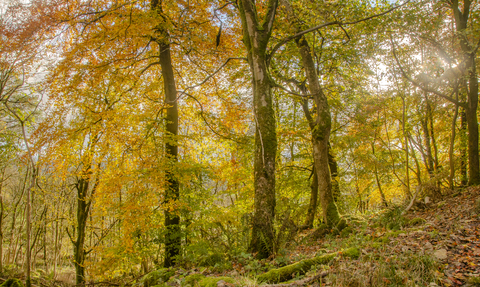
Chafer Wood Nature Reserve - Laura Popely
Chafer Wood Nature Reserve
Location
Know before you go
Dogs
When to visit
Opening times
Open at all times. We recommend a half day trip to this reserve but if you'd like to extend your outing why not combine with a visit to Ellerburn Bank, Fen Bog or Robinson's Field, or enjoy the attractions at Thornton-le-Dale, Pickering and Dalby Forest?Best time to visit
May to SeptemberAbout the reserve
Climb the valley sides of young woodland and scrub, where small open glades contain limestone grassland. The shaded lower parts of the valley, which have been wooded for longer, are covered in delicate ferns and mosses, and rare species of cranefly thrive. Look for baneberry, goldilocks buttercup and leopard’s bane by the stream. Resident birds include green and great spotted woodpeckers and nuthatch, with redstart and blackcap arriving in spring.
Go on a clear day to enjoy the views from King Alfred's Cairn, built in 1770 to commemorate the battle of Ebberston, and have a nosy at the ancient pinfold restored by the Trust
Species
Contact us
About
Chafer Wood supports an interesting variety of habitats and is home to a wide range of plants and birds.
The shaded lower parts of the valley are rarely exposed to sunlight and are therefore covered in delicate ferns and mosses. By the stream running through the nature reserve, woodland plants such as bluebells, baneberry, goldilocks buttercup and leopard’s bane can be found, whilst a carpet of wild garlic (ramsons) fills the air with an oniony fragrance during the spring.
Roe deer are very much in evidence on the site and may well be encountered on a quiet stroll. Rare species of cranefly also thrive, as conditions in the valley bottom create the perfect habitat in which to breed.
Birds you might come across include nuthatch, redstart, blackcap, green and great spotted woodpeckers.
In addition to the woodland there are areas of limestone grassland that form small open glades within the trees.
Seasonal highlights
- Spring: Plants - Wild cherry; Cowslip; Bluebell; Birds - Redstart
- Summer: Plants - Pyramidal orchid; Rock-rose; Invertebrates - Craneflies Birds - Green woodpecker
- Autumn: Mammals - Fox; Roe deer
- Winter: Birds - Sparrowhawk; Treecreeper
History
Before Yorkshire Wildlife Trust took ownership of the site in 1992, some areas had been used as a plantation, evident by small populations of introduced trees like sycamore and larch.
Management by the Trust is focussed on removing these introduced tree species and replanting with native species which are then protected from deer and rabbit damage.
Bracken is managed by cutting so it does not encroach and shade out other pants, whilst the open areas of limestone grassland are strimmed once or twice a year with the cuttings raked up to create habitat piles for insects to use.
Some historical interest remains on the site, including an ancient pinfold near the entrance which has been restored by the Trust.
A 200 years old structure, known as King Alfred’s Cairn also exists, although excavation in the 1950s of the cave beneath revealed human remains dating back to Neolithic times.
Directions
Public transport
The nearest train station is at Scarborough. A bus runs through Ebberston along the A170.
By car
From Pickering head east on the A170 to Ebberston. Pass The Grapes Inn and then turn left, north up a narrow lane. The nature reserve is found a short way up the lane on the left, with spaces to park alongside.
Beautiful gem of a place, not seen so many bluebells in all my life!Google Reviews

The autumn colours were even more beautiful when the sun came out
Photo Credit - Telling our Story Volunteer, Sara



